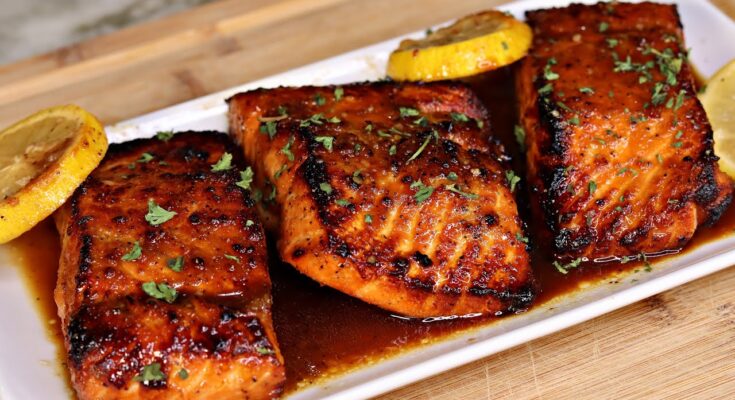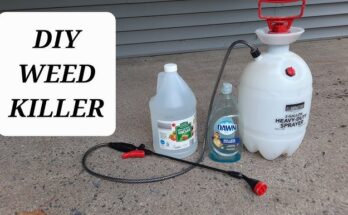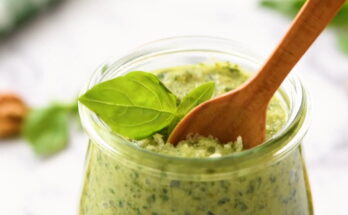Glazed Salmon Recipe: If you’re hunting for a dish that’s both mouthwatering and ridiculously easy to whip up, glazed salmon should be at the top of your list. With its tender, flaky texture and a perfectly caramelized glaze, this dish brings a gourmet feel to your dinner table without requiring a culinary degree. It’s not just for seafood lovers either; even those on the fence about fish tend to fall in love with this juicy, flavorful entrée.
So, what makes glazed salmon such a crowd-pleaser? It’s the perfect blend of sweet, tangy, and umami-rich flavors that cling to each bite of salmon like a culinary hug. You can serve it with rice, steamed veggies, or even flake it into a salad for something a little lighter. Plus, it’s versatile enough for weeknight dinners and impressive enough for special occasions.
But here’s the kicker — glazed salmon is also incredibly good for you. That brings us to our next point…
Why Glazed Salmon is a Must-Try Dish
Salmon isn’t just tasty — it’s a nutrition powerhouse. It’s packed with omega-3 fatty acids, which are fantastic for heart health and brain function. It’s also a great source of high-quality protein, essential vitamins like B12, and minerals such as selenium and potassium. When you combine these health benefits with the sheer deliciousness of a sticky, sweet glaze, you’ve got a meal that’s as smart as it is satisfying.
And let’s not forget how quick and simple this recipe is. From fridge to fork in under 30 minutes, glazed salmon proves that healthy eating doesn’t have to be complicated or boring.
Ingredients Needed for Glazed Salmon
Core Ingredients
Before you even preheat that oven or fire up your skillet, you need to gather the essentials. Here’s what you’ll need for a basic but delicious glazed salmon:
- Salmon fillets – 4 pieces, about 6 oz each
- Soy sauce – ¼ cup
- Honey or maple syrup – 3 tbsp
- Brown sugar – 2 tbsp
- Garlic – 2 cloves, minced
- Ginger – 1 tbsp, grated
- Olive oil – 1 tbsp
- Lemon juice or lime juice – 1 tbsp
- Salt and pepper – to taste
These are the building blocks for your glaze — the soy sauce brings saltiness, the honey or maple syrup adds sweetness, and the ginger and garlic give it that aromatic punch.
Optional Add-ons for Extra Flavor
Want to give your salmon a little more flair? Try tossing in some of these:
- Red pepper flakes – for heat
- Dijon mustard – for a touch of tang
- Orange zest – to brighten the flavor
- Sesame seeds – for garnish and crunch
- Green onions – finely sliced for topping
These extras can elevate your glaze and turn a basic recipe into your signature dinner-party showstopper.
Tools and Equipment Required
Kitchen Tools for Cooking Salmon
You don’t need a fancy kitchen setup to make glazed salmon, but a few key tools will make your cooking process smoother and more efficient:
- Non-stick skillet or grill pan – for even searing and cooking
- Mixing bowls – to whip up your glaze
- Measuring spoons and cups – for precise ingredient portions
- Spatula or tongs – to flip and handle the fish
- Baking dish or tray (optional) – if you prefer oven-baked salmon
- Whisk – to ensure your glaze is smooth and well-combined
Tips for Choosing the Right Cookware
Non-stick pans are a lifesaver when it comes to salmon. They prevent sticking and help the glaze caramelize without burning. If you’re using an oven, a baking tray lined with parchment paper or foil makes cleanup easier and keeps the fish moist.
Cast iron skillets are also great — they hold heat beautifully and give your salmon a fantastic sear. Just make sure to oil the pan properly so your fish doesn’t stick.
Preparing the Salmon
How to Select Fresh Salmon
The key to a killer glazed salmon starts at the store. Here’s how to pick the best fillets:
- Color: Look for a vibrant pink or reddish hue. Dull, pale fish is a no-go.
- Smell: Fresh salmon should smell like the ocean — clean and briny, not fishy.
- Texture: The fillet should feel firm, not mushy. When you press it, it should bounce back.
If you’re buying frozen, make sure it’s vacuum-sealed and free from ice crystals or freezer burn.
Cleaning and Prepping the Fish
Once you’ve got your salmon home, it’s time to prep:
- Rinse the fillets under cold water and pat them dry with paper towels. Moisture is the enemy of a good sear.
- Remove any pin bones by running your fingers over the fillet and using tweezers to pluck them out.
- Season lightly with salt and pepper on both sides. This helps the flavor shine through and preps the surface for the glaze to stick.
Now your salmon’s ready to hit the pan!
Making the Glaze
Sweet and Savory Glaze Ingredients
Let’s get that glaze going! Here’s a basic yet delicious combination that you can customize:
- ¼ cup soy sauce
- 3 tbsp honey (or maple syrup)
- 2 tbsp brown sugar
- 1 tbsp fresh lemon juice
- 1 tbsp grated ginger
- 2 cloves garlic, minced
- Optional: 1 tsp Dijon mustard, ½ tsp red pepper flakes
This mixture hits every flavor note — sweet, salty, tangy, and spicy.
Step-by-Step Glaze Preparation
- In a small saucepan, combine all the glaze ingredients.
- Heat over medium, whisking frequently to prevent burning.
- Simmer for 5-7 minutes, or until the sauce thickens slightly and becomes glossy.
- Taste test! Adjust the seasoning if needed. A dash more honey for sweetness? A pinch more pepper for kick? Make it yours.
Once your glaze is ready, it’s time to bring everything together.
Cooking the Salmon
Pan-Searing Method
Pan-searing is a favorite method for cooking glazed salmon because it gives the fillets a deliciously crispy crust while locking in moisture. Here’s how to do it right:
- Heat your pan: Place a non-stick or cast-iron skillet over medium-high heat and add a tablespoon of olive oil.
- Sear the salmon: Once the oil is hot and shimmering, place the salmon fillets skin-side down (if they have skin) in the pan. Cook undisturbed for about 4-5 minutes.
- Flip carefully: Turn the fillets over with a spatula or tongs, being gentle to avoid breaking them apart.
- Add the glaze: Spoon your glaze over the top and allow it to bubble and caramelize for another 3-4 minutes.
- Check for doneness: The salmon should flake easily with a fork and have an opaque center. An internal temperature of 125–130°F (51–54°C) is ideal for medium.
Oven-Baking Method
For those who prefer a hands-off approach, baking is your best bet. It’s a great option for batch cooking or when entertaining guests.
- Preheat your oven to 400°F (200°C).
- Line a baking tray with parchment paper or aluminum foil and place the salmon fillets evenly spaced.
- Brush with glaze: Generously coat the top of each fillet with your glaze mixture.
- Bake for 12-15 minutes, depending on the thickness of your salmon.
- Finish with broil: For that beautiful caramelized top, broil for an additional 1-2 minutes. Watch closely to avoid burning.
Grilling Option
Craving those smoky grill marks and summer BBQ vibes? Grilling glazed salmon is absolutely doable.
- Preheat the grill to medium-high and oil the grates.
- Place the salmon skin-side down and cook for 6-8 minutes, brushing with glaze throughout.
- Flip and cook for another 2-3 minutes on the flesh side, finishing with a final glaze coat.
How to Serve Glazed Salmon
Best Side Dishes to Pair With
Glazed salmon is rich, so pairing it with fresh, vibrant sides can balance the meal beautifully. Here are some fantastic options:
- Steamed jasmine or brown rice – the glaze mixes in beautifully
- Roasted vegetables – like asparagus, broccoli, or carrots
- Quinoa salad – for a high-protein, low-carb option
- Garlic mashed potatoes – comfort food at its finest
- Cucumber dill salad – light and refreshing contrast
Plating Like a Pro
Presentation makes all the difference when it comes to impressing your guests (or just treating yourself). Here are some tips:
- Use a wide white plate for contrast
- Place a scoop of rice or veggies in the center and lean the salmon fillet against it
- Drizzle extra glaze artistically over the top
- Garnish with sesame seeds, green onions, or a lemon wedge
A beautifully plated dish makes your glazed salmon not just a meal, but a visual treat.
Tips and Tricks for Perfect Glazed Salmon
Avoiding Common Mistakes
Even though it’s a simple dish, a few missteps can turn your salmon from fab to flop:
- Don’t overcook: Dry salmon is the enemy! Keep an eye on timing and use a meat thermometer if unsure.
- Watch the glaze: Sugary glazes can burn quickly. Keep your heat at medium and don’t walk away.
- Use fresh ingredients: Especially when it comes to garlic, ginger, and citrus. They make a big flavor difference.
Flavor Variations to Try
Don’t be afraid to mix things up! Here are a few creative twists:
- Asian-style: Add hoisin sauce and sesame oil to the glaze
- Spicy kick: Toss in Sriracha or chipotle paste
- Citrus pop: Try orange juice and zest instead of lemon
- Tropical flair: Mix in pineapple juice and a splash of coconut aminos
These little changes can make the recipe feel fresh and new every time.
Storing and Reheating Leftovers
How to Store Properly
Got leftovers? Lucky you! Glazed salmon keeps well and makes a fantastic next-day meal.
- Refrigerate: Store in an airtight container for up to 3 days.
- Freeze: Wrap in foil and place in a ziplock bag for up to 2 months. Be sure to remove as much air as possible.
Reheating Without Losing Flavor
The key is to reheat gently to keep the salmon moist and tasty:
- Oven: Wrap in foil and warm at 275°F (135°C) for about 10-12 minutes.
- Microwave: Use medium power and a microwave-safe cover. Heat in 30-second intervals to avoid overcooking.
- Stovetop: Place in a covered skillet with a splash of water and steam over low heat.
Nutritional Benefits of Glazed Salmon
Packed with Omega-3 Fatty Acids
One of the biggest health perks of salmon is its rich omega-3 content. These essential fats are powerful for brain function, reducing inflammation, and supporting heart health. Eating salmon just twice a week can drastically improve cholesterol levels and decrease the risk of heart disease.
Glazed salmon combines this health boost with flavor, making it a perfect option for anyone trying to eat better without sacrificing taste. Whether you’re following a keto, paleo, or Mediterranean diet, this dish fits right in.
High-Quality Protein Source
Salmon is a lean protein that provides all nine essential amino acids your body needs. A single serving of glazed salmon can offer up to 25 grams of protein, making it ideal for muscle repair, satiety, and metabolism. For athletes or fitness enthusiasts, it’s a great way to nourish your body post-workout.
Plus, unlike red meats, salmon contains minimal saturated fats, which makes it heart-smart and waistline-friendly.
Glazed Salmon for Special Diets
Gluten-Free Modifications
If you’re gluten-sensitive or have celiac disease, glazed salmon can still be on the menu. Simply swap regular soy sauce for tamari or a certified gluten-free soy sauce. Everything else in the recipe is naturally gluten-free, making it a safe and flavorful choice.
You can also serve the salmon with gluten-free grains like quinoa or wild rice, and side it with roasted veggies or salads for a balanced, bloat-free meal.
Low-Carb and Keto Adjustments
Watching your carb intake? The glaze does include some sugar, but you can easily modify it for a low-carb or keto lifestyle:
- Use sugar-free maple syrup or monk fruit sweetener as a substitute for honey and brown sugar.
- Stick to a simple soy sauce, garlic, and lemon glaze for an ultra-low-carb option.
Pair it with sautéed spinach or cauliflower rice, and you’ve got a gourmet keto dinner that tastes like a cheat meal — without the guilt.
Creative Ways to Use Leftover Glazed Salmon
Salmon Salad Bowls
Leftover salmon is perfect for throwing into a fresh salad. Try this combo:
- Mixed greens or arugula
- Cherry tomatoes
- Avocado slices
- Cucumbers
- Crumbled feta
- Drizzle with lemon vinaigrette or your leftover glaze
Flake the salmon over the top and boom — a healthy lunch that’s ready in minutes.
Salmon Tacos
Who doesn’t love tacos? Warm up your glazed salmon, flake it, and add it to corn tortillas with:
- Shredded cabbage
- Pickled red onions
- Cilantro
- A squeeze of lime
- A dollop of Greek yogurt or chipotle mayo
It’s a flavor explosion and an easy way to make dinner exciting again.
Salmon Fried Rice
Chop up your glazed salmon and toss it into a hot wok with:
- Day-old rice
- Peas and carrots
- Soy sauce
- Scrambled egg
- Green onions
The sweet glaze caramelizes and mixes with the rice for a satisfying, quick one-pan meal.
Sustainable Salmon Choices
Farmed vs. Wild-Caught
When buying salmon, it’s worth considering where it comes from. Wild-caught salmon is often praised for its superior flavor and higher levels of omega-3s. It also tends to have fewer contaminants and is more sustainably harvested, depending on the source.
Farmed salmon, while more affordable and widely available, varies in quality. Look for responsibly farmed options with eco-certifications to ensure ethical sourcing.
Eco-Friendly Certifications to Look For
Keep an eye out for these labels to make environmentally conscious choices:
- MSC (Marine Stewardship Council) – for wild-caught sustainable fisheries
- ASC (Aquaculture Stewardship Council) – for responsible fish farming
- Seafood Watch Recommendations – from the Monterey Bay Aquarium
By choosing sustainable salmon, you’re not just feeding yourself — you’re helping protect marine ecosystems too.
Why Glazed Salmon is a Go-To Dinner Option
Quick and Easy
Let’s be real — life’s busy. And cooking elaborate meals every night? Not gonna happen. That’s where glazed salmon comes in. It’s:
- Ready in 30 minutes or less
- Uses pantry-friendly ingredients
- Works with whatever veggies or carbs you have on hand
It’s like that reliable friend who always shows up, makes you feel good, and doesn’t ask for much in return.
Family-Friendly and Versatile
Even picky eaters tend to enjoy glazed salmon. The sweet-savory glaze makes it taste more like comfort food than “healthy food.” And because it pairs with so many sides, it’s easy to adapt to whatever your crew likes.
You can also scale the recipe up or down depending on how many you’re feeding, and leftovers are anything but boring.
Expert Tips for Cooking Salmon Like a Pro
Temperature Matters
Cooking salmon to the right internal temperature is critical. Aim for:
- Medium-rare: 120°F (49°C)
- Medium: 125–130°F (52–54°C)
- Well-done: 135°F+ (57°C+), though this may result in dryness
Use a meat thermometer inserted into the thickest part of the fillet for an accurate read. Remember, salmon continues to cook a bit after removing it from heat due to carryover cooking, so pull it slightly early.
Rest the Fish
Like steak, salmon benefits from a rest period after cooking. Let it sit for 3–5 minutes before serving. This allows the juices to redistribute, ensuring a moist and tender bite every time.
Caramelization is Key
To get that golden, glossy finish, let the glaze bubble and thicken toward the end of cooking. Don’t stir it too much. Let it do its thing and coat the salmon with a candy-like shell of flavor. That’s what takes this dish from good to unforgettable.
FAQs about Glazed Salmon Recipe
Q1: Can I use frozen salmon for this recipe?
Yes, you can use frozen salmon. Just make sure to thaw it completely in the refrigerator before cooking. This ensures even cooking and better glaze absorption.
Q2: What type of glaze works best for salmon?
Popular choices include honey garlic, soy sauce-based, maple mustard, or teriyaki glazes. These enhance the natural flavor of salmon and create a delicious caramelized finish.
Q3: How do I know when my salmon is fully cooked?
Salmon is done when it flakes easily with a fork and reaches an internal temperature of 145°F (63°C). The flesh should be opaque and moist in the center.
Q4: Can I grill glazed salmon instead of baking it?
Absolutely! Grilling adds a smoky flavor. Just make sure to oil the grill grates and watch closely, as the sugar in the glaze can cause flare-ups.
Q5: What sides go well with glazed salmon?
Great side dishes include steamed rice, roasted vegetables, quinoa, mashed potatoes, or a fresh green salad. The goal is to balance the sweet-savory flavor of the glaze.
Q6: How long can I store leftover glazed salmon?
Store leftovers in an airtight container in the fridge for up to 3 days. Reheat gently to preserve the texture and flavor.
Q7: Can I make the glaze ahead of time?
Yes! Most glazes can be made 2–3 days ahead and stored in the fridge. Just reheat slightly before brushing it on the salmon.
Q8: Is glazed salmon healthy?
Yes, especially when baked or grilled. Salmon is rich in omega-3 fatty acids and protein. To keep it healthy, use natural sweeteners and limit high-sodium sauces.
Q9: Can I make it spicy?
Of course! Add a pinch of chili flakes, sriracha, or cayenne pepper to the glaze to bring in some heat without overpowering the flavor.
Q10: Can I use other types of fish?
Yes. Glazed recipes work well with trout, cod, or halibut. Adjust the cooking time based on the thickness of the fish.
Conclusion
Glazed salmon is one of those rare recipes that checks all the boxes: quick, easy, nutritious, and outrageously delicious. Whether you’re hosting guests or feeding your family on a busy weeknight, this dish delivers every time. With the right ingredients, a few handy tools, and a little love, you can create a gourmet-level meal in your own kitchen — no reservations required.
And the best part? It’s endlessly customizable. From the choice of sweetener to the cooking method and even the garnishes, there’s room to make it uniquely yours.
So grab some fresh salmon, whip up a sticky glaze, and get ready to impress — your taste buds and your dinner guests alike.



